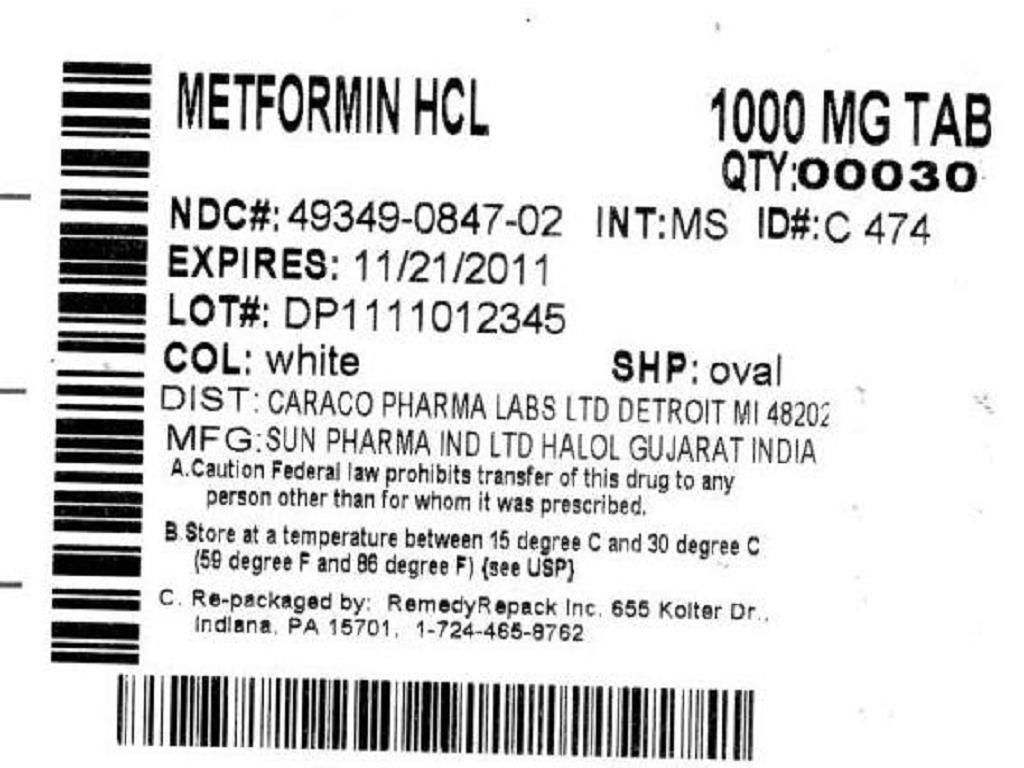Metformin Hydrochloride
FULL PRESCRIBING INFORMATION: CONTENTS*
- BOXED WARNING
- METFORMIN HYDROCHLORIDE DESCRIPTION
- CLINICAL PHARMACOLOGY
- CLINICAL STUDIES
- INDICATIONS & USAGE
- METFORMIN HYDROCHLORIDE CONTRAINDICATIONS
- PRECAUTIONS
- INFORMATION FOR PATIENTS
- LABORATORY TESTS
- DRUG INTERACTIONS
- CARCINOGENESIS & MUTAGENESIS & IMPAIRMENT OF FERTILITY
- PREGNANCY
- NURSING MOTHERS
- PEDIATRIC USE
- GERIATRIC USE
- METFORMIN HYDROCHLORIDE ADVERSE REACTIONS
- OVERDOSAGE
- DOSAGE & ADMINISTRATION
- HOW SUPPLIED
- STORAGE AND HANDLING
- INFORMATION FOR PATIENTS
- PACKAGE LABEL.PRINCIPAL DISPLAY PANEL SECTION
FULL PRESCRIBING INFORMATION
BOXED WARNING
Lactic Acidosis:are generally found.
The reported incidence of lactic acidosis in patients receiving metformin hydrochloride tablets, USP is very low (approximately 0.03 cases/1000 patient-years, with approximately 0.015 fatal cases/1000 patient-years). In more than 20,000 patient-years exposure to metformin in clinical trials, there were no reports of lactic acidosis. Reported cases have occurred primarily in diabetic patients with significant renal insufficiency, including both intrinsic renal disease and renal hypoperfusion, often in the setting of multiple concomitant medical/surgical problems and multiple concomitant medications. Patients with congestive heart failure requiring pharmacologic management, in particular those with unstable or acute congestive heart failure who are at risk of hypoperfusion and hypoxemia are at increased risk of lactic acidosis. The risk of lactic acidosis increases with the degree of renal dysfunction and the patient's age. The risk of lactic acidosis may, therefore, be significantly decreased by regular monitoring of renal function in patients taking metformin and by use of the minimum effective dose of metformin. In particular, treatment of the elderly should be accompanied by careful monitoring of renal function. Metformin hydrochloride tablets, USP treatment should not be initiated in patients80 years of age unless measurement of creatinine clearance demonstrates that renal function is not reduced, as these patients are more susceptible to developing lactic acidosis. In addition, metformin should be promptly withheld in the presence of any condition associated with hypoxemia, dehydration or sepsis. Because impaired hepatic function may significantly limit the ability to clear lactate, metformin should generally be avoided in patients with clinical or laboratory evidence of hepatic disease. Patients should be cautioned against excessive alcohol intake, either acute or chronic, when taking metformin hydrochloride tablets, USP since alcohol potentiates the effects of metformin hydrochloride tablets, USP on lactate metabolism. In addition, metformin should be temporarily discontinued prior to any intravascular radiocontrast study and for any surgical procedure (see alsoPRECAUTIONS). The onset of lactic acidosis often is subtle, and accompanied only by nonspecific symptoms such as malaise, myalgias, respiratory distress, increasing somnolence and nonspecific abdominal distress. There may be associated hypothermia, hypotension and resistant bradyarrhythmias with more marked acidosis. The patient and the patient's physician must be aware of the possible importance of such symptoms and the patient should be instructed to notify the physician immediately if they occur (see alsoPRECAUTIONS). Metformin hydrochloride tablets, USP should be withdrawn until the situation is clarified. Serum electrolytes, ketones, blood glucose and, if indicated, blood pH, lactate levels and even blood metformin levels may be useful. Once a patient is stabilized on any dose level of metformin, gastrointestinal symptoms, which are common during initiation of therapy, are unlikely to be drug related. Later occurrence of gastrointestinal symptoms, could be due to lactic acidosis or other serious disease.
Levels of fasting venous plasma lactate above the upper limit of normal but less than 5 mmol/L in patients taking metformin do not necessarily indicate impending lactic acidosis and may be explainable by other mechanisms, such as poorly controlled diabetes or obesity, vigorous physical activity or technical problems in sample handling. (See alsoPRECAUTIONS.)
Lactic acidosis should be suspected in any diabetic patient with metabolic acidosis lacking evidence of ketoacidosis (ketonuria and ketonemia).
Lactic acidosis is a medical emergency that must be treated in a hospital setting. In a patient with lactic acidosis who is taking metformin, the drug should be discontinued immediately and general supportive measures promptly instituted. Because metformin hydrochloride tablets, USP are dialyzable (with a clearance of up to 170 mL/min under good hemodynamic conditions), prompt hemodialysis is recommended to correct the acidosis and remove the accumulated metformin. Such management often results in prompt reversal of symptoms and recovery. (See alsoCONTRAINDICATIONSANDPRECAUTIONS).
METFORMIN HYDROCHLORIDE DESCRIPTION

CLINICAL PHARMACOLOGY
Mechanism of Action
PRECAUTIONS
Pharmacokinetics
Absorption and Bioavailability
Distribution
Metabolism and Elimination
Special Populations
Patients with Type 2 Diabetes
Renal Insufficiency
WARNINGS
Hepatic Insufficiency
Geriatrics
WARNINGSDOSAGE AND ADMINISTRATION
Table 1. Select Mean (Metformin Pharmacokinetic Parameter Following Single or Multiple Oral Doses of Metformin Hydrochloride Tablets, USPSubject Groups: Metformin dosea (number of subjects)Cmaxb (Tmaxc (hrs)Renal Clearence (mL/min)Healthy, nondiabetic adults:500 mg single dose (24)1.03 (2.75 (600 (850 mg single dose (74)d1.60 (2.64 (552 (850 mg three times daily for 19 dosese (9)2.01 (1.79 (642 (Adults with type 2 diabetes:850 mg single dose (23)1.48 (3.32 (491 (850 mg three times daily for 19 dosese (9)1.90 (2.01 (550 (Elderlyf, healthy nondiabetic adults:850 mg single dose (12)2.45 (2.71 (412 (Renal-impaired adults:850 mg single doseMild (CLcrg 61-90 mL/min) (5)1.86 (3.20 (384 (Moderate (CLcr 31-60 mL/min) (4)4.12 (3.75 (108 (Severe (CLcr 10-30 mL/min) (6)3.93 (4.01 (130 (
Pediatrics
After administration of a single oral metformin hydrochloride 500 mg tablet with food, geometric mean metformin Cmax and AUC differed less than 5% between pediatric type 2 diabetic patients (12 to 16 years of age) and gender- and weight-matched healthy adults (20 to 45 years of age), all with normal renal function.
Gender
Metformin pharmacokinetic parameters did not differ significantly between normal subjects and patients with type 2 diabetes when analyzed according to gender (males = 19, females = 16). Similarly, in controlled clinical studies in patients with type 2 diabetes, the antihyperglycemic effect of metformin hydrochloride tablets, USP was comparable in males and females.
Race
No studies of metformin pharmacokinetic parameters according to race have been performed. In controlled clinical studies of metformin hydrochloride tablets, USP in patients with type 2 diabetes, the antihyperglycemic effect was comparable in whites (n=249), blacks (n=51) and hispanics (n=24).
CLINICAL STUDIES
Table 2. Metformin Hydrochloride Tablets, USP vs Placebo Summary of Mean Changes from Baseline* in Fasting Plasma Glucose HbA1c and Body Weight, at Final Visit (29-week study)Metformin hydrochloride tablets, USP (n = 141)Placebo (n = 145)P-value
Table 3. Combined Metformin Hydrochloride Tablets, USP / Glyburide (Comb) vs Glyburide (Glyb) or Metformin Hydrochloride Tablets, USP (Met) Monotherapy: Summary of Mean Changes from Baseline* in Fasting Plasma Glucose, HBA1c and Body Weight at Final Visit (29-week study)p-valuesComb (n = 213)Glyb (n = 209)Met (n = 210)Glyb Vs CombMet Vs combMet Vs Glyb
Table 4. Summary of Mean Percent Change from Baseline of Major Serum Lipid Variables at Final Visit (29-week studies)Metformin Vs PlaceboCombined Metformin/Glyburide Vs MonotherapyMetformin (N = 141)Placebo (N = 145)Metformin (n = 210)Metformin/Glyburide (n = 213)Glyburide (n = 209)
Table 5. Combined Metformin Hydrochloride Tablets, USP/Insulin vs Placebo/Insulin Summary of Mean Changes from Baseline in HbA1c and Daily Insulin DoseMetformin Hydrochloride tablets, USP/Insulin n=26Placebo/Insulin n=28Treatment difference MeanSE
Pediatric Clinical Studies
Table 6. Metformin Hydrochloride Tablets, USP vs Placebo (Pediatricsa) Summary of Mean Changes from Baseline* in Plasma Glucose and Body Weight at Final VisitMetformin hydrochloride tablets, USPPlaceboP-ValueFPG (mg/dL)(n = 37)(n = 36)
INDICATIONS & USAGE
METFORMIN HYDROCHLORIDE CONTRAINDICATIONS
WARNINGSPRECAUTIONS
PRECAUTIONS.
PRECAUTIONS
General
Macrovascular Outcomes
Monitoring of renal function
WARNINGSDOSAGE AND ADMINISTRATION
Use of concomitant medications that may affect renal function or metformin disposition
PRECAUTIONS: Drug Interactions
Radiologic studies involving the use of intravascular iodinated contrast materials (for example, intravenous urogram, intravenous cholangiography, angiography, and computed tomography (CT) scans with intravascular contrast materials)
CONTRAINDICATIONS
Hypoxic states
Surgical procedures
Alcohol intake
Impaired hepatic function
Vitamin B12 levels
PRECAUTIONS: Laboratory Tests
Change in clinical status of patients with previously controlled type 2 diabetes
WARNINGS
Hypoglycemia
Loss of control of blood glucose
INFORMATION FOR PATIENTS
WARNINGSPRECAUTIONS
Patient Information
LABORATORY TESTS
DOSAGE AND ADMINISTRATIONDRUG INTERACTIONS
(Clinical Evaluation of Drug Interactions Conducted with metformin)Glyburide
DOSAGE AND ADMINISTRATION: Concomitant Metformin Hydrochloride Tablets, USP and Oral Sulfonylurea Therapy in Adult Patients
Furosemide
Nifedipine
Cationic Drugs
Other
CARCINOGENESIS & MUTAGENESIS & IMPAIRMENT OF FERTILITY
PREGNANCY
Teratogenic Effects: Pregnancy Category B.NURSING MOTHERS
PEDIATRIC USE
CLINICAL PHARMACOLOGY: Pediatric Clinical Studies.ADVERSE REACTIONS: Pediatric Patients.DOSAGE AND ADMINISTRATION: Recommended Dosing Schedule: Pediatrics.GERIATRIC USE
CONTRAINDICATIONSWARNINGS,CLINICAL PHARMACOLOGY: PharmacokineticsWARNINGSDOSAGE AND ADMINISTRATIONMETFORMIN HYDROCHLORIDE ADVERSE REACTIONS
Table 7. Most Common Adverse Reactions (>5.0%) in a Placebo-Controlled Clinical Study of Metformin Monotherapy*Metformin Monotherapy n=141Placebo n=145Adverse Reaction% of Patients
Pediatric Patients
OVERDOSAGE
WARNINGSDOSAGE & ADMINISTRATION
Recommended Dosing ScheduleThe therapeutic goal should be to decrease both fasting plasma glucose and glycosylated hemoglobin levels to normal or near normal by using the lowest effective dose of metformin hydrochloride tablets, USP either when used as monotherapy or in combination with sulfonylureas or insulin.
Recommended Dosing Schedule
Adults
Pediatrics
Transfer from Other Antidiabetic Therapy
Concomitant Metformin Hydrochloride Tablets, USP and Oral Sulfonylurea Therapy in Adult Patients
CLINICAL PHARMACOLOGY: Clinical Studies
Concomitant Metformin Hydrochloride Tablets, USP and Insulin Therapy in Adult Patients
Specific Patient Populations
WARNINGS.
HOW SUPPLIED
STORAGE AND HANDLING
INFORMATION FOR PATIENTS
METFORMIN HYDROCHLORIDE TABLETS, USPWhat is Metformin?
WARNING
A small number of people who have taken metformin have developed a serious condition called lactic acidosis. Lactic acidosis is caused by a buildup of lactic acid in the blood. This happens more often in people with kidney problems. Most people with kidney problems should not take metformin. (SeeWhat are the side effects of metformin?)
Who should not take metformin?
Do not take metformin if you:
-
● have kidney problems
-
● have liver problems
-
● have heart failure that is treated with medicines, such as Lanoxin(digoxin) or Lasix(furosemide)
-
● drink a lot of alcohol. This means you binge drink for short periods or drink all the time
-
● are seriously dehydrated (have lost a lot of water from your body)
-
● are going to have an x-ray procedure with injection of dyes (contrast agents)
-
● are going to have surgery
-
● develop a serious condition, such as heart attack, severe infection, or a stroke
-
● are 80 years or older and you have NOT had your kidney function tested
Can metformin hydrochloride tablets, USP be used in children?
How should I take metformin hydrochloride tablets, USP?
-
● have an illness that causes severe vomiting, diarrhea or fever, or if you drink a much lower amount of liquid than normal. These conditions can lead to severe dehydration (loss of water in your body). You may need to stop taking metformin for a short time.
-
● plan to have surgery or an x-ray procedure with injection of dye (contrast agent). You may need to stop taking metformin hydrochloride tablets for a short time.
-
● start to take other medicines or change how you take a medicine. Metformin can affect how well other drugs work, and some drugs can affect how well metformin works. Some medicines may cause high blood sugar.
What should I avoid while taking metformin hydrochloride tablets, USP?
What are the side effects of metformin?
Lactic Acidosis.
In rare cases, metformin can cause a serious side effect called lactic acidosis. This is caused by a buildup of lactic acid in your blood. This build-up can cause serious damage.
stop using metformin and call your doctor right away if you have signs of lactic acidosis. Lactic acidosis is a medical emergency that must be treated in a hospital.
Signs of lactic acidosis are:
-
● feeling very weak, tired, or uncomfortable
-
● unusual muscle pain
-
● trouble breathing
-
● unusual or unexpected stomach discomfort
-
● feeling cold
-
● feeling dizzy or lightheaded
-
● suddenly developing a slow or irregular heartbeat
Other Side Effects.
General advice about prescription medicines
PACKAGE LABEL.PRINCIPAL DISPLAY PANEL SECTION


Metformin HydrochlorideMetformin Hydrochloride TABLET
| ||||||||||||||||||||||||||||||||||||||||||||||||||||||||||||||||||||||||||||||||
PLEASE, BE CAREFUL!
Be sure to consult your doctor before taking any medication!